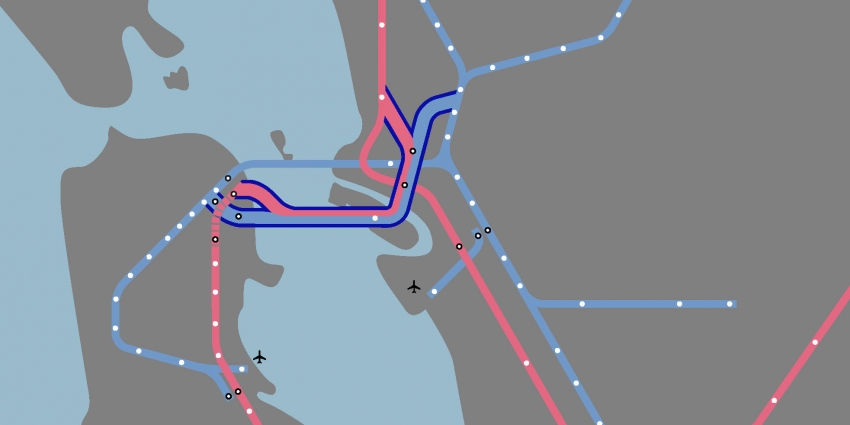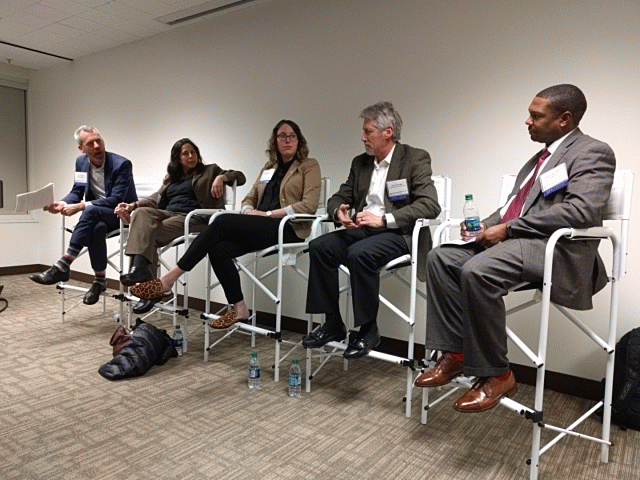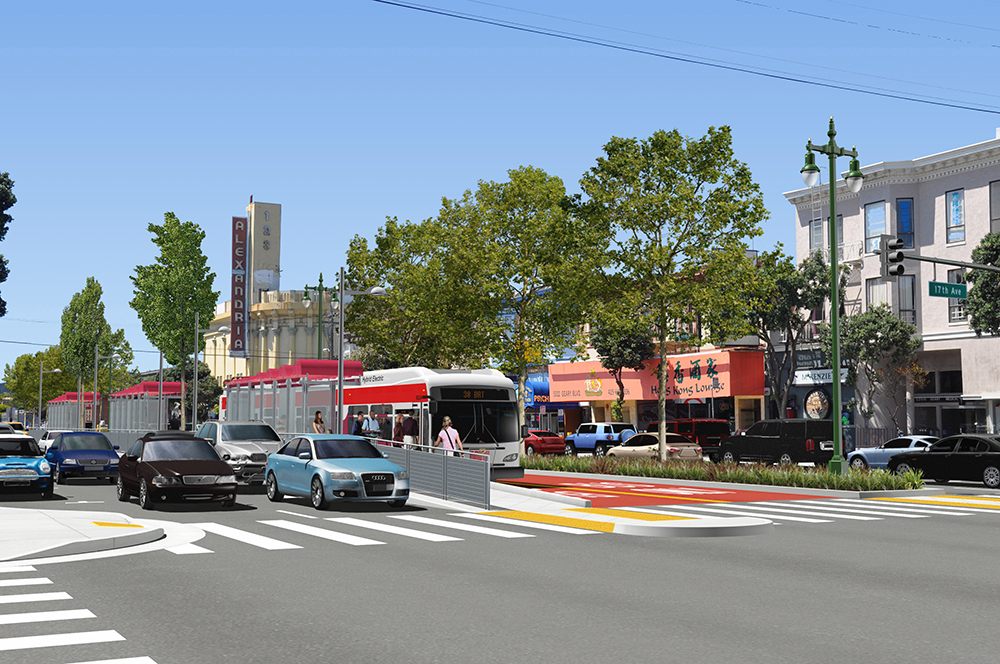It costs $2.25 to go one block on the Geary 38 bus, but someone driving a Tesla can use all of San Francisco's streets for free. "It’s fundamentally inequitable" said Jeff Tumlin, Principal and Director of Strategy at NelsonNygaard Consulting, during a panel discussion at San Francisco's Urban Land Institute. "We even manage traffic signals based on vehicle progression" rather than on how many people move through an intersection, "so a person on a bus is valued at 1/200th of a person driving in a car," said Tumlin. Last night's panel about the future challenges of transportation and housing featured transit officials, developers, and Debs Schrimmer, Transportation Policy Manager for Lyft.
Moving forward, suggested Schrimmer, it may be time to start asking solo drivers to pay to use the streets of downtown, especially during congested periods. "It's done in London, Stockholm, Milan, Singapore… conversations about congestion pricing are happening in New York," she said. "San Francisco last looked at it in 2007; it’s time has come again." She added that, if universally applied, it would act as an incentive for people to share rides and result in better efficiencies.
In theory, that could help companies such as Lyft, since traffic should be minimized and more people would be deterred from driving a private car into the city. Schrimmer added that the real success of Lyft hinges on robust public transportation. "Lyft’s vision for 2040 is similar to what many of you want to see: walkable, bikeable, dense communities." To her, ride-hail services are about helping to solve the last-mile problem and supplement transit, which is why she stressed the importance of building a second Transbay tube and extending Caltrain to downtown San Francisco. "A transit backbone is key."
[caption id="attachment_329922" align="aligncenter" width="850"]
"Transportation is a basic right, not just a privilege of the very wealthy," said Julie Kirschbaum, Chief Transit Officer for the SFMTA and another of the panelists. "That requires high-occupancy transit to be more reliable and quicker than it is today."
For that to be achieved, the city has to correct the undervaluing of a bus or light-rail passenger at "1/200th of a person driving a car." Kirschbaum said the agency wants to "carve out more space" for transit. That means more red-carpet/transit-only lanes, and, hopefully, moving forward on Bus Rapid Transit on Geary. She also said Muni rail has to become more flexible and reliable. "The new platform for the Warriors Arena will have crossovers before and behind ... We’ll be able to turn trains around. That’s important to managing infrastructure."
But Kirschbaum also sees an inherent conflict between better transit and ride-hail services. And that conflict, she said, has to be managed. "For example, at the Outside Lands music festival, we set up an urban fence so Lyft pickups don’t get in the way of the fifty buses we staged on Fulton Street to get people out." But right now forcing ride hails to limit pickups and drop-offs to designated loading zones isn't "something that everyone is opting in to... you have to regulate the other systems that are compromising the more efficient experience."
[caption id="attachment_332568" align="aligncenter" width="1194"]
Meanwhile, Sean Brooks, Real Estate and Property Development Manager for BART, also wants that second BART tube, plus increased frequencies on all the lines. Also: "more seamless connectivity with TNCs and future autonomous vehicles," he said, adding that fare payment technology has to "let all systems integrate and talk to each other." Especially in BART's more suburban environment, that could reduce demand for parking, because people could bike to stations or take a TNC. That would free up surface parking lots to be developed for housing and shopping, which would allow people to live closer to the stations, which in turn could reduce driving further--at least in theory. "Do we grow up or out as a region? Do we continue to expand our system to the Stocktons of the world, or do we intensify and densify the land uses around our stations? The answer is a combination of both." He said the key is to slowly replace surface level parking with drop-off locations and mixed-use developments.
Tumlin wondered if, given the price of land and the cost of maintaining parking spaces, it wouldn't be cheaper for BART to develop its parking lots into housing and pay for a last-mile trip in a TNC for BART patrons. "BART controls some of the most valuable real estate in the region," he said. "A parking spot costs at least $20 per day," to maintain that real estate, "and if you’re charging $2 or $3 for a parking spot, it’s cheaper to provide free Lyft service than to continue to subsidize parking."
"Parking is not the evil thing; it’s not," said Jon Knorpp, Senior Managing Director, Giants Development Services. "We run the most transit-friendly ballpark in the industry, with fifty percent of the people who come to a game taking something other than a single occupancy car." Those people, he said, take ferries, trains, buses--but "you’re not going to convince the guy in Gilroy with eight kids not to drive." That's why the ballpark still maintains some parking.
But as his company develops Mission Bay, it is trying to keep new parking structures flexible. As he explained, housing needs financing, and bankers require a certain amount of parking. So, he said, they are focusing on parking structures rather than street parking, and on consolidating parking into those structures. "How do we do it so we can potentially use that structure for other uses?" He explained that by keeping the top floors of the 3,000 spot parking structures flat, they hope some day to convert them to more housing or office space.
[caption id="attachment_354741" align="aligncenter" width="1008"]
"We developed the first master plan that doesn’t have one on-street parking spot--it's all delivery zones for TNCs, with parking aggregated into one building to keep the cars at the perimeter," Knorpp explained. "If you’re driving a car into Mission Rock, you're either lost or dropping someone off."
Tumlin, meanwhile, worried that the inefficiency of government in delivering public transit improvements was cursing the region to continued reliance on automobiles and autocentric design. "We have private companies running on the public right of way. But the city also needs to provide a more competitive product. Look at [improvements for] Van Ness and Geary, which have been in the works for so many years--and we still haven’t broken ground on Geary BRT!"
Kirschbaum seemed to blame the hypocrisy of San Francisco voters for that. "Everybody is transit-first at the 50,000-foot level, and nobody is transit-first when you remove their bus stop or their parking space," said Kirschbaum. Stakeholders complain, plans are revised, stakeholders complain again--and projects get watered down and delayed.
Tumlin agreed, pointing out that the complaints of a handful of people can have an unwarranted impact, often gumming up the works for the entire city, which is what happened with Geary BRT. "We’re in a city that is managed by complaint, so two people can manage 200,000 people," he said.
[caption id="attachment_354730" align="aligncenter" width="640"] Jeff Tumlin, Julie Kirschbaum, Debs Schrimmer, Jon Knorpp, and Sean Brooks at Tuesday evenings ULI panel[/caption]
Jeff Tumlin, Julie Kirschbaum, Debs Schrimmer, Jon Knorpp, and Sean Brooks at Tuesday evenings ULI panel[/caption]
For more events like this, check out ULI's Events Page.






